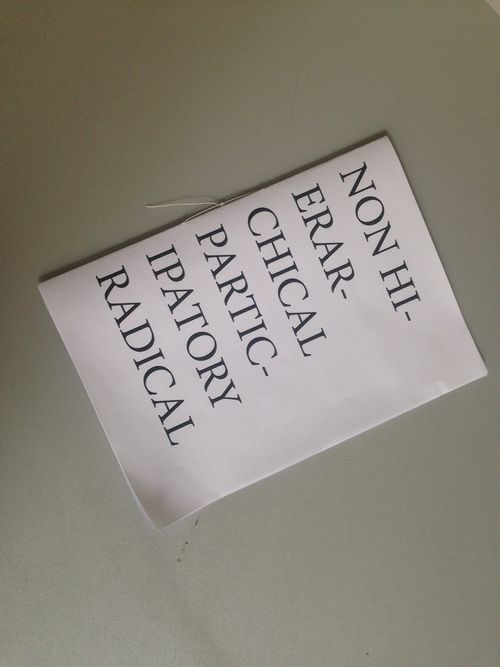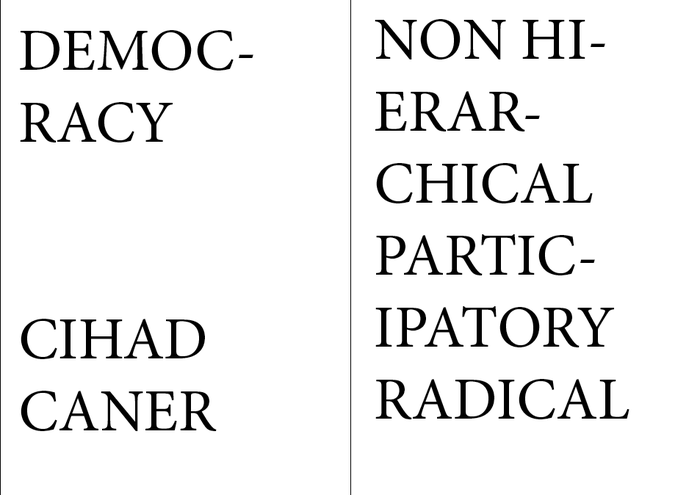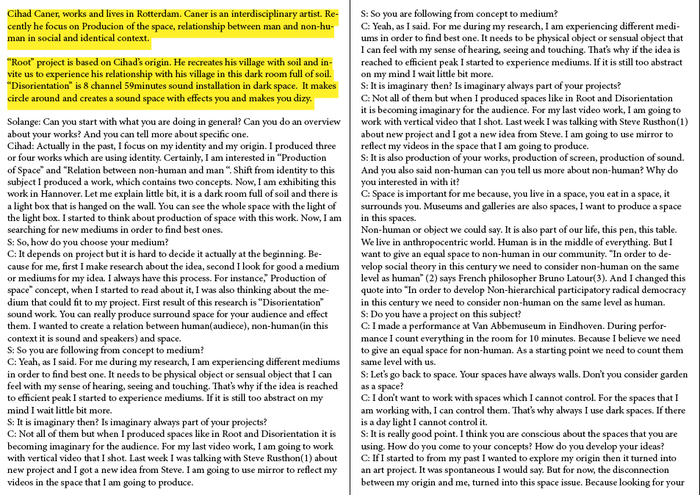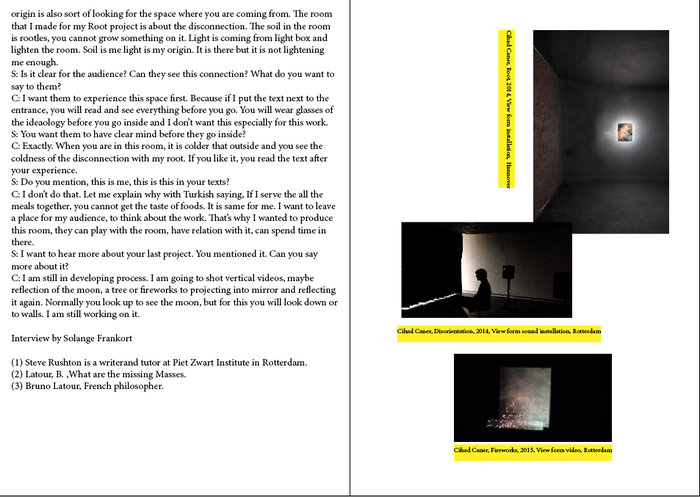Interview about my practice
Solange and Cihad First Version
S: Can you start with what you are doing in general? Can you do an overview about your works? And you can tell more about specific one.
C: Thank you. Actually in the past, I focus on my identity and my origin. I produced three or four works which are using identity. Certainly, I am interested in “Production of Space”. Shift from identity to this idea I produced a work, which contains two concepts. I am exhibition this work in Hannover. Let me explain little bit, it is a dark room full of soil and there is a light box that is hanged on the wall. You can see the whole space with the light of the light box. I started to think about production of space with this work. Now I am searching for new mediums in order to find best ones.
S: Let’s go back for a second. I want to talk about mediums. What kind of mediums do you use, in your works?
C: I am interdisciplinary artist, I am not just working a specific medium but if I say, photography, video, installation, book, sound.
S: So, how do you choose your medium?
C: It is good question. It is hard to decide it actually at the beginning because for me first I make research about the idea second I look for good medium for my idea. I always have this process. For instance, for Production of space idea, when I started to read about it, I was also thinking about the medium that could fit to my project. First result of this research was “Disorientation” sound work. You really produce surround space for your audience.
S: So you are also following from concept to medium?
C: Yeah, as I said. For me during my research I am experiencing different mediums in order to find best one. It needs to be physical object that I can feel with my sense of hearing, seeing, touching. That’s why if the idea is reached to efficient peak I started to experience mediums. If it is still too abstract on my mind I wait little bit more.
S: But for you sound installation you cannot see it?
C: Yeah you right you cannot see it but it is also about perception and different senses.
S: It is imaginary then? Is imaginary always part of your projects?
C: Himm, not part of all of them but when I produced a space it is becoming imaginary for the audience. For my last video work, I am going to work with vertical video that I shot. Last week I was talking with Steve about this new project and I got a new idea from Steve. I am going to use mirror to reflect my videos in the space that I am going to produce.
S: It is also production of your works, production of screen, production of sound.
C: Yeah, you right. Space is important for me because, you live in a space, you eat in a space, it surrounds you. Museums and galleries are also spaces, I want to produce a space in this spaces.
S: Your spaces have always walls. Don’t you consider garden as a space?
C: I don’t want to work ,which I cannot control. For the spaces that I am working with, I can control them. That’s why always I use dark spaces. If there is a day light I cannot control it.
S: It is really good point. I think you are conscious about the spaces that you are using. How do you come to your concepts? How do you develop your ideas? How do you start it?
C: If I started to from my past I want to explore my origin then it turned into art project. It was spontaneous I would say. But for now, the disconnection between my origin and me turned me into this space issue. Because looking for your origin is also sort of looking for the space where you are coming from. The room that I made for my Root project is about the disconnection. The soil in the room is rootles, you cannot grow something on it. Light is coming from light box and lighten the room. Soil is me light is my origin. It is there but it is not lightening me enough.
S: Is it clear for the audience? Can they see this connection? What do you want to say them?
C: I want them to experience this space first. Because if I put the text next to the entrance, you will read and see everything before you go. You will wear glass of the main idea before you go inside and I don’t want this especially for this work.
S: You want them to have clear mind before they go inside?
C: Yeah, exactly. When you are in this room, it is colder that outside and you see the coldness of the disconnection with my root. If you like it, you read the text after you experience.
S: Do you mention, this is me, this is this in the text?
C: No I don’t do that. Let me explain why, If I serve the all the meal together, you cannot get the taste of foods. It is same for me. I want to leave a place for my audience, to think about the work. That’s why I wanted to produce this room, they can play with the room, have relation with it, can spend time in there.
S: I want to hear more about your last project. You mentioned it. Can you say more about it?
C: I am still in developing process. I am going to shot vertical videos, maybe reflection of the moon, to projecting into mirror and reflecting it again. Normally you look up to see the moon, but for this you will look down or to walls. I am still working on it.
S: You can experiment it. It sounds nice.
C: I will do it. I will play with it.
S: Do you have any idea of your final project? Can you say something about it, if you have?
C: It is still not clear what I am going to do for next year but I know it is going to be related to Production of the Space.
Edited version
Cihad Caner, works and lives in Rotterdam. Caner is an interdisciplinary artist. Recently he focus on Producion of the space, relationship between man and non-human in social and identical context.
“Root” project is based on Cihad’s origin. He recreates his village with soil and invite us to experience his relationship with his village in this dark room full of soil. “Disorientation” is 8 channel 59minutes sound installation in dark space. It makes circle around and creates a sound space with effects you and makes you dizy.
Solange: Can you start with what you are doing in general? Can you do an overview about your works? And you can tell more about specific one. Cihad: Actually in the past, I focus on my identity and my origin. I produced three or four works which are using identity. Certainly, I am interested in “Production of Space” and “Relation between non-human and man “. Shift from identity to this subject I produced a work, which contains two concepts. Now, I am exhibiting this work in Hannover. Let me explain little bit, it is a dark room full of soil and there is a light box that is hanged on the wall. You can see the whole space with the light of the light box. I started to think about production of space with this work. Now, I am searching for new mediums in order to find best ones.
Cihad Caner, Root, 2014, View form installation, Hannover
S: So, how do you choose your medium?
C: It depends on project but it is hard to decide it actually at the beginning. Because for me, first I make research about the idea, second I look for good a medium or mediums for my idea. I always have this process. For instance,” Production of space” concept, when I started to read about it, I was also thinking about the medium that could fit to my project. First result of this research is “Disorientation” sound work. You can really produce surround space for your audience and effect them. I wanted to create a relation between human(audiece), non-human(in this context it is sound and speakers) and space.
Cihad Caner, Disorientation, 2014, View form sound installation, Rotterdam
S: So you are following from concept to medium?
C: Yeah, as I said. For me during my research, I am experiencing different mediums in order to find best one. It needs to be physical object or sensual object that I can feel with my sense of hearing, seeing and touching. That’s why if the idea is reached to efficient peak I started to experience mediums. If it is still too abstract on my mind I wait little bit more.
S: It is imaginary then? Is imaginary always part of your projects?
C: Not all of them but when I produced spaces like in Root and Disorientation it is becoming imaginary for the audience. For my last video work, I am going to work with vertical video that I shot. Last week I was talking with Steve Rusthon(1) about new project and I got a new idea from Steve. I am going to use mirror to reflect my videos in the space that I am going to produce.
S: It is also production of your works, production of screen, production of sound. And you also said non-human can you tell us more about non-human? Why do you interested in with it?
C: Space is important for me because, you live in a space, you eat in a space, it surrounds you. Museums and galleries are also spaces, I want to produce a space in this spaces. Non-human or object we could say. It is also part of our life, this pen, this table. We live in anthropocentric world. Human is in the middle of everything. But I want to give an equal space to non-human in our community. “In order to develop social theory in this century we need to consider non-human on the same level as human” (2) says French philosopher Bruno Latour(3). And I changed this quote into “In order to develop Non-hierarchical participatory radical democracy in this century we need to consider non-human on the same level as human.
S: Do you have a project on this subject?
C: I made a performance at Van Abbemuseum in Eindhoven. During performance I count everything in the room for 10 minutes. Because I believe we need to give an equal space for non-human. As a starting point we need to count them same level with us.
S: Let’s go back to space. Your spaces have always walls. Don’t you consider garden as a space?
C: I don’t want to work with spaces which I cannot control. For the spaces that I am working with, I can control them. That’s why always I use dark spaces. If there is a day light I cannot control it.
S: It is really good point. I think you are conscious about the spaces that you are using. How do you come to your concepts? How do you develop your ideas?
C: If I started to from my past I wanted to explore my origin then it turned into an art project. It was spontaneous I would say. But for now, the disconnection between my origin and me, turned into this space issue. Because looking for your origin is also sort of looking for the space where you are coming from. The room that I made for my Root project is about the disconnection. The soil in the room is rootles, you cannot grow something on it. Light is coming from light box and lighten the room. Soil is me light is my origin. It is there but it is not lightening me enough.
S: Is it clear for the audience? Can they see this connection? What do you want to say to them?
C: I want them to experience this space first. Because if I put the text next to the entrance, you will read and see everything before you go. You will wear glasses of the ideaology before you go inside and I don’t want this especially for this work.
S: You want them to have clear mind before they go inside?
C: Exactly. When you are in this room, it is colder that outside and you see the coldness of the disconnection with my root. If you like it, you read the text after your experience.
S: Do you mention, this is me, this is this in your texts?
C: I don’t do that. Let me explain why with Turkish saying, If I serve the all the meals together, you cannot get the taste of foods. It is same for me. I want to leave a place for my audience, to think about the work. That’s why I wanted to produce this room, they can play with the room, have relation with it, can spend time in there.
S: I want to hear more about your last project. You mentioned it. Can you say more about it?
C: I am still in developing process. I am going to shot vertical videos, maybe reflection of the moon, a tree or fireworks to projecting into mirror and reflecting it again. Normally you look up to see the moon, but for this you will look down or to walls. I am still working on it.
Cihad Caner, Fireworks, 2015, View form video, Rotterdam
(1) Steve Rusthon researcher based on text and tutor at Piet Zwart Institute in Rotterdam.
(2) Latour, B. ,What are the missing Masses.
(3) Bruno Latour, French philosopher.




